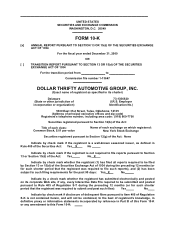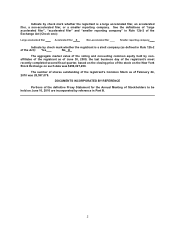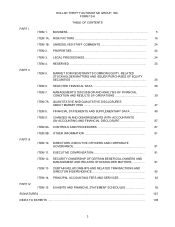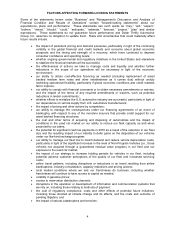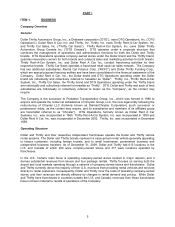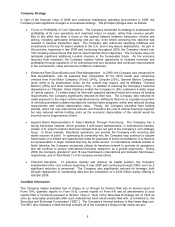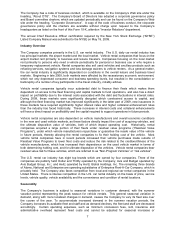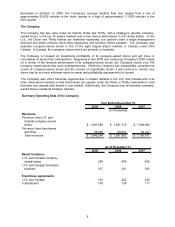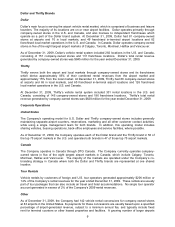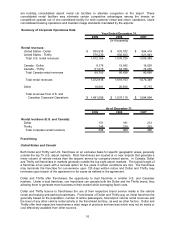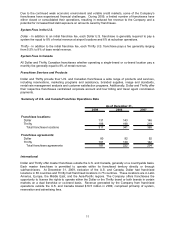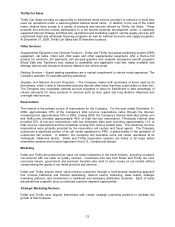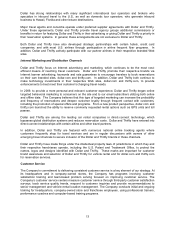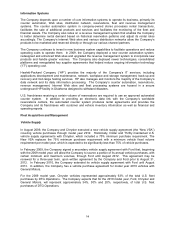Thrifty Car Rental 2009 Annual Report Download - page 5
Download and view the complete annual report
Please find page 5 of the 2009 Thrifty Car Rental annual report below. You can navigate through the pages in the report by either clicking on the pages listed below, or by using the keyword search tool below to find specific information within the annual report.FACTORS AFFECTING FORWARD-LOOKING STATEMENTS
Some of the statements herein under “Business” and “Management’s Discussion and Analysis of
Financial Condition and Results of Operations” contain “forward-looking statements” about our
expectations, plans and performance. These statements use such words as “may,” “will,” “expect,”
“believe,” “intend,” “should,” “could,” “anticipate,” “estimate,” “forecast,” “project,” “plan” and similar
expressions. These statements do not guarantee future performance and Dollar Thrifty Automotive
Group, Inc. assumes no obligation to update them. Risks and uncertainties that could materially affect
future results include:
x the impact of persistent pricing and demand pressures, particularly in light of the continuing
volatility in the global financial and credit markets and concerns about global economic
prospects and the timing and strength of a recovery, which have continued to depress
consumer confidence and spending levels;
x whether ongoing governmental and regulatory initiatives in the United States and elsewhere
to stabilize the financial markets will be successful;
x the effectiveness of actions we take to manage costs and liquidity and whether further
reductions in the scope of our operations will be necessary in light of the economic
environment;
x our ability to obtain cost-effective financing as needed (including replacement of asset
backed medium term notes and other indebtedness as it comes due) without unduly
restricting operational flexibility, particularly if global economic conditions and credit markets
fail to improve;
x our ability to comply with financial covenants or to obtain necessary amendments or waivers,
and the impact of the terms of any required amendments or waivers, such as potential
reductions in lender commitments;
x whether efforts to revitalize the U.S. automotive industry are successful, particularly in light of
our dependence on vehicle supply from U.S. automotive manufacturers;
x the impact of pricing and other actions by competitors;
x our ability to manage the consequences under our financing agreements of an event of
bankruptcy with respect to any of the monoline insurers that provide credit support for our
asset backed financing structures;
x the cost and other terms of acquiring and disposing of automobiles and the impact of
conditions in the used car market on our ability to reduce our fleet capacity as and when
projected by our plans;
x the potential for significant cash tax payments in 2010 as a result of the reduction in our fleet
size and the resulting impact of our inability to defer gains on the disposition of our vehicles
under our like-kind exchange program;
x our ability to manage our fleet mix to match demand and reduce vehicle depreciation costs,
particularly in light of the significant increase in the level of Non-Program Vehicles (i.e., those
vehicles not acquired through a guaranteed residual value program) in our fleet and our
exposure to the used car market;
x the impact of our strategy to increase holding periods for vehicles in our fleet, including
potential adverse customer perceptions of the quality of our fleet and increased servicing
costs;
x airline travel patterns, including disruptions or reductions in air travel resulting from airline
bankruptcies, industry consolidation, capacity reductions and pricing actions;
x local market conditions where we and our franchisees do business, including whether
franchisees will continue to have access to capital as needed;
x volatility in gasoline prices;
x access to reservation distribution channels;
x disruptions in the operation or development of information and communication systems that
we rely on, including those relating to methods of payment;
x the cost of regulatory compliance, costs and other effects of potential future initiatives,
including those directed at climate change and its effects, and the costs and outcome of
pending litigation; and
x the impact of natural catastrophes and terrorism.
4


